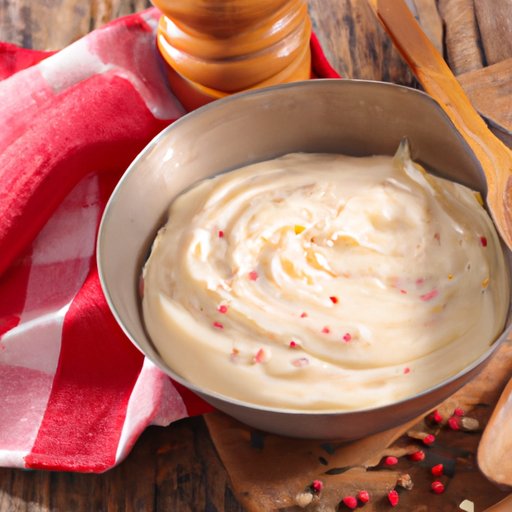I. Introduction
Have you ever been excited to serve a dish, only to find the sauce is too thin and runs all over the plate? It’s a common problem that can be frustrating for any home cook. Fear not – this guide will teach you everything you need to know about thickening sauces. From cornstarch to roux to cream and butter, we’ve got you covered.
II. The Basics: Thickening with Cornstarch, Flour, or Arrowroot
There are a few standard ingredients used for thickening sauces, such as cornstarch, flour, and arrowroot. Cornstarch is the most popular choice and works well for clear sauces. Flour, on the other hand, adds flavor and works well for thicker sauces like gravy. Arrowroot is good for acidic sauces as it doesn’t break down when exposed to acidic ingredients like other thickeners can.
When using cornstarch or flour, it is important to mix them with cold liquid before adding them to a hot sauce. This will prevent lumps from forming. As a general rule, use one tablespoon of either cornstarch or flour per cup of liquid. For arrowroot, two teaspoons per cup of liquid should do the trick.
III. Thickening Sauces for Different Dishes
Every dish requires a different technique when it comes to thickening the sauce. For example, beef stew benefits from a roux-based gravy, while alfredo sauce gets its creaminess from butter and Parmesan cheese. Tomato sauce can be thickened with pureed tomatoes or tomato paste, or with one of the standard thickeners mentioned above.
IV. Tips on Preventing Lumps
No one likes lumpy sauce! To prevent this, it is crucial to whisk constantly while adding thickeners to hot liquid. Additionally, some ingredients should be at room temperature before mixing, like eggs for hollandaise sauce. Adjusting the temperature of each ingredient will help create a smoother sauce.
V. Lesson on Roux
Roux is a mixture of melted fat and flour that is used to thicken sauces. There are three types: white, blonde, and brown. White roux is the lightest and is perfect for cream sauces. Blonde roux has a nuttier flavor and is great for gravies. Brown roux has a caramelized flavor and is used for gumbo and other dark sauces.
When creating a roux, whisk melted butter with flour over low heat until it forms a paste. Then, slowly add liquid while whisking constantly. The longer you cook the roux, the darker it will get and the more flavor it will have.
VI. Reducing Sauce to Thicken
Reducing a sauce is a simple way to thicken it while also intensifying the flavors. Heat the sauce over medium heat and let it simmer until it reaches the desired consistency. Note that reducing a sauce too much can result in a saltier taste, so be careful. Balsamic reduction is a classic example of this technique.
VII. Cream and Butter as Thickeners
Adding cream or butter to a sauce can create a smooth and silky consistency. Cream is perfect for pasta sauces, while butter is great for gravies. However, be wary of adding too much cream or butter, as it can overpower the dish or result in a slimy texture.
VIII. Surprising Solids as Thickeners
Believe it or not, ingredients like mashed potatoes, pureed nuts, and cooked rice can be used to thicken sauces. Mashed potatoes work well in creamy soups, while pureed nuts add depth to a sauce. Cooked rice can also be blended with a bit of liquid to thicken Asian sauces and soups.
IX. Conclusion
Whichever technique you choose, remember that practice makes perfect. Don’t be afraid to experiment and try new methods until you find the one that works best for you. With the tips provided in this article, you’ll be able to thicken your sauces with ease and confidence in every dish you create.
